There are eight Doppler Effect Formulas for frequency depending on cases:
(i) When the source is moving towards a observer at rest

(ii) When the source is moving away from the observer at rest

(iii) When observer is moving towards the stationary source

(iv) When observer moving away from a stationary source

(v) When both Source and observer moves towards each other





Hyperopia, also known as farsightedness, long-sightedness or hypermetropia, is a defect of eye as the light is focuses at a point behind the retina not on the retina of the eye. Here, the victim can see distance object but near vision is difficult and causes strain. Hence hypermetropic people are called long-sighted.

Convex lens is used to rectify the vision or improve the vision. These lens converges rays of light which are traveling parallel to its principal axis meet at the focus. They produce real images. The lens of human eye is a double convex lens.
Myopia or Near sightedness is a deficiency of an eye, mostly due to error occurs with the focal length of the lens of the human eye. Here the victim is able to see near objects but far objects appear blurred.This disorder is when light entering the eye is focused incorrectly, making distant objects appear blurred.
Figure show an eye with such deficiency receiving light rays from a far off object. Due to the deficiency, the rays get focused ahead of the retina (the screen) and hence the eye is unable to perceive the object clearly.
Thus the image extends between points Im and Ip and a sharp point image is not possible for a point object . This defect is called spherical aberration . The distance between Im and Ip is the measure of the spherical aberration and is called the longitudinal (axial ) spherical aberration

The Electromagnetic spectrum is divided into several regions based on different frequencies, wavelengths and their characteristics. The figure shown below shows the Electromagnetic Spectrum Diagram which consists of all the em waves with respect to the wavelength and frequencies.
The Regions of the Electromagnetic Spectrum are as follows:
Infrared wave:
The infrared wave lies between 300 GHz to 405 THz and hence the infrared wavelength is in between 750 nm – 1 mm. The near infrared lies between 0.75-1.4 μμm wavelength range of infrared region while the far infrared lies between 15 – 1000 μμm wavelength range of infrared region. Infrared spectrometers are generally used to study the Vibrational Spectra of molecules.
Visible light :
The frequencies in this region can be sensed by our eyes and interpreted as colors ranging from violet to red. With the violet having shorter wavelength and higher frequency while the red color have higher wavelength and shorter frequency.
Ultraviolet wave or rays :
The ultraviolet rays lie above the visible spectrum and are invisible to our eyes. These waves can be felt as sun burns.
X-rays :
The X-rays lie above the ultraviolet band and are produced by the sudden stoppage of the high speed charged particle by the use of metal target which absorbs these particles and hence the x-rays are emitted by such particles.
Gamma rays :
The Gamma rays are of extremely low wavelength and are produced by the radioactive decay of the radioactive atoms.
The term LASER is an acronym for Light Amplification by Stimulated Emission of Radiation. The first laser was constructed in 1960.
(a) Action.
The action of a laser can be explained in terms of energy levels. A material whose atoms are excited emits radiation when electrons in higher energy levels return to lower levels. Normally this occurs randomly, i.e. spontaneous emission occurs, and the radiation is emitted in all directions and is incoherent. The emission of light from ordinary sources is due to this process. However, if a photon of exactly the correct energy approaches an excited atom, an electron in a higher energy level may be induced to fall to a lower level and emit another photon. The remarkable fact is that this photon has the same phase, frequency and direction of travel as the stimulating photon which is itself unaffected. This phenomenon was predicted by Einstein and is called stimulated emission
In a laser it is arranged that light emission by stimulated emission exceeds that by spontaneous emission. To achieve this it is necessary to have more electrons in an upper than a lower level. Such a condition, called an ‘inverted population’, is the reverse of the normal state to affairs but it is essential for light amplification, i.e. for a beam of light to increase in intensity as it passes through a material rather than to decrease as is usually the case.
One method of creating an inverted population is known as ‘optical pumping’ and consists of illuminating the laser material with light. Consider two levels of energies E1 and E2, where E2 > E1. If the pumping radiation contains photons of frequency (E2- E1)/h, electrons will be raised from level 1 to level 2 by photon absorption. Unfortunately, however, as soon as the electron population in level 2 starts to increase, the pumping radiation induces stimulated emission from level 2 to level 1, since it is of the correct frequency and no build up occurs.
In a three level system, the pumping radiation of frequency (E3- E1)/h, raises electrons from level 1 to level 3, from which they fall by spontaneous emission to level 2. An inverted population can arise between level 2 and 1 if electrons remain long enough in level 2. The spontaneous emission of a photon due to an electronic fall from level 2 to level 1 may subsequently cause the stimulated emission of a photon which in turn releases more photons from other atoms. The laser action thus occurs between level 2 and 1 and the pumping radiation has different frequency from that o the stimulated radiation.

(b) Ruby Laser
Many materials can be used in laser. The ruby rod laser consists of a synthetic crystal of aluminium oxide containing a small amount of chromium as the laser material. It is a type of three-level leaser in which ‘level’3 consists of a band of very close energy levels. The pumping radiation, produced by intense flashes of yellow-green light from a flash tube, raises electrons from level 1 ( the ground level) into one of the levels of the band. From there they fall spontaneously to the metastable level 2 where they can remain for approximately 1 millisecond, as compared with 10-8 second in the energy band. Red laser light is emitted when they are stimulated to fall to level 1 from 2. One end of the ruby rod is silvered to act as a complete reflector whilst the other is thinly silvered and allow partial transmission. Stimulated light photons are reflected to and fro along the rod producing an intense beam, part of which emerges from the partially
silvered end as the useful output of the laser.

(c) Helium – neon laser.
This uses a mixture of helium and neon, and whereas the ruby laser emits short pulses of light, it works continuously and produces a less divergent beam. In one form the gas is in a long quartz tube with an optically flat mirror at each end. Pumping is done by a 28 M Hz r.f. generator instead of a flash tube. An electric discharge in the gas pumps the helium atoms to a higher energy level. They then excite the neon atoms to a higher level by collision and produce an inverted population of neon atom which emit radiation when they are stimulated to fall to a lower level.
(d). Uses.
Semiconductor lasers are used in optical fibre communication systems. Ruby lasers are used for range finding, welding, drilling and microcircuit fabrication. Helium-Neon lasers are used for the precision measurement of length, surveying, printing and holography.
Speed and velocity
Acceleration
Acceleration is defined as rate of change of velocity.
Linear motion equations
v=u+at S=ut+½at² v²=u²+2as S=½(v+u)/t
Gradient of a displacement vs time graph gives velocity.
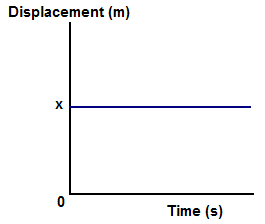 gradient = 0 m/s so velocity = 0 m/s
gradient = 0 m/s so velocity = 0 m/s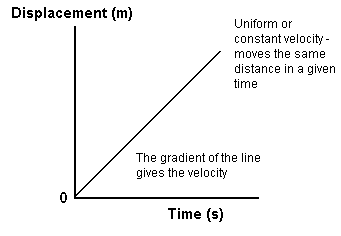


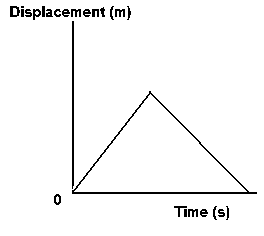
Gradient of a velocity-time graph gives acceleration. Area under v-t graph gives displacement.
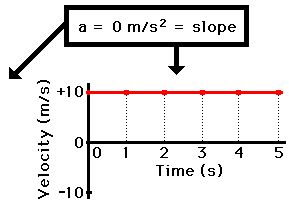 Uniform velocity
Uniform velocity
| Positive Velocity Zero Acceleration |
Positive Velocity Positive Acceleration |
|---|---|
 |
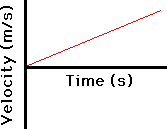 |

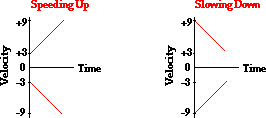 Accelerating Decelerating
Accelerating DeceleratingAcceleration vs Time graph
Area=at=v-u=change in velocity
Center of mass
The center of mass of a distribution of mass in space is the unique point where the weighted relative position of the distributed mass sums to zero or the point where if a force is applied causes it to move in direction of force without rotation.
In the case of a single rigid body, the center of mass is fixed in relation to the body, and if the body has uniform density, it will be located at the centroid. The center of mass may be located outside the physical body, as is sometimes the case for hollow or open-shaped objects, such as a horseshoe.
Center of gravity
A body’s center of gravity is the point around which the resultant torque due to gravity forces vanishes. Where a gravity field can be considered to be uniform, the center of mass and the center of gravity will be the same. However, for satellites in orbit around a planet, in the absence of other torques being applied to a satellite, the slight variation in gravitational field between closer to and further from the planet can lead to a torque that will tend to align the satellite such that its long axis is vertical. In such a case, it is important to make the distinction between the center of gravity and the center of mass. Any horizontal offset between the two will result in an applied torque.
It is useful to note that the center of mass is a fixed property for a given rigid body , whereas the center of gravity may, in addition, depend upon its orientation in a non-uniform gravitational field. In the latter case, the center of gravity will always be located somewhat closer to the main attractive body as compared to the center of mass and thus will change its position in the body of interest as its orientation is changed.
Referring to the mass-center as the center of gravity is something of a colloquialism, but it is in common usage and when gravity gradient effects are negligible, center-of-gravity and cente of mass are the same and are used interchangeably.
Conditions for the Equilibrium
Conditions for the Equilibrium of Three Non-Parallel Forces
If we say that an object is under the influence of forces which are in equilibrium, we mean that the object is not accelerating – there is no net force acting.The object may still be travelling but at a constant velocity
| i) | The lines of action of the three forces must all pass through the same point. |
| ii) | The principle of moments: the sum of all the clock-wise moments about any point must have the same magnitude as the sum of all the anti-clockwise moments about the same point. |
| iii) |
a) The sum of all the forces acting vertically upwards must have the same magnitude as the sum of all the forces acting vertically downwards |
Lami’s theorem states that if three forces acting at a point are in equilibrium, each force is proportional to the sine of the angle between the other two forces.
Consider three forces A, B, C acting on a particle or rigid body making angles α, β and γ with each other.
According to Lami’s theorem, the particle shall be in equilibrium if


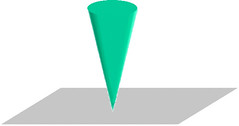
A cone cannot be made to stand on its tip. Theoretically, this feat might be possible if the cone could be placed with its center of gravity exactly in a vertical line through through the tip.
The cone would then be in equilibrium under the action of the force of gravity on it acting downwards and an equal and opposite reaction to its weight exerted on it by the table. But even if this condition could be achieved momentarily, the slightest vibration of the draught would inevitably cause the cone to tilt.
The force of gravity, W, would then exert a turning force about the tip, and this would cause the cone to topple over. A cone placed on its tip is said to be in unstable equilibrium.
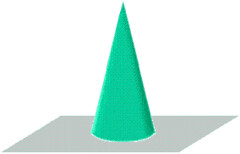
The image shows the cone standing on its base. If tilted from this position, even through a fairly large angle, the vertical line through the center of gravity, G, will still fall inside the base.
Consequently, the force of gravity on the cone will have a moment W × x about an edge of the base which will pull the cone back into its original position.
Under these conditions, it is not easy to knock the cone over, and it is said to be in stable equilibrium.

Now, the cone is lying on its side. the base is simply a straight line, and if the cone is rolled into a new position the vertical line through the center of gravity still continues to pass through exactly the same point in the base.
Whatever the position of the cone, the reaction from the table will act in the same straight line as the force of gravity through G, and so the cone will be in equilibrium. The force of gravity exerts no moment about the base as axis and, if displaced, the cone will therefore remain at rest in its new position. This condition is described as neutral equilibrium.
It should be clear from the above explanation that the stability of a body depends on the direction of the turning moment exerted by the force of gravity on the body about the edge of the base, when the body is given a small displacement.
If a small displacement brings the vertical through the center of gravity outside the base the body will be unstable. If, however, the vertical remains within the base the body will be stable.
When a displacement causes no change in the position of the vertical through the center of gravity with respect to the base the body is in neutral equilibrium.